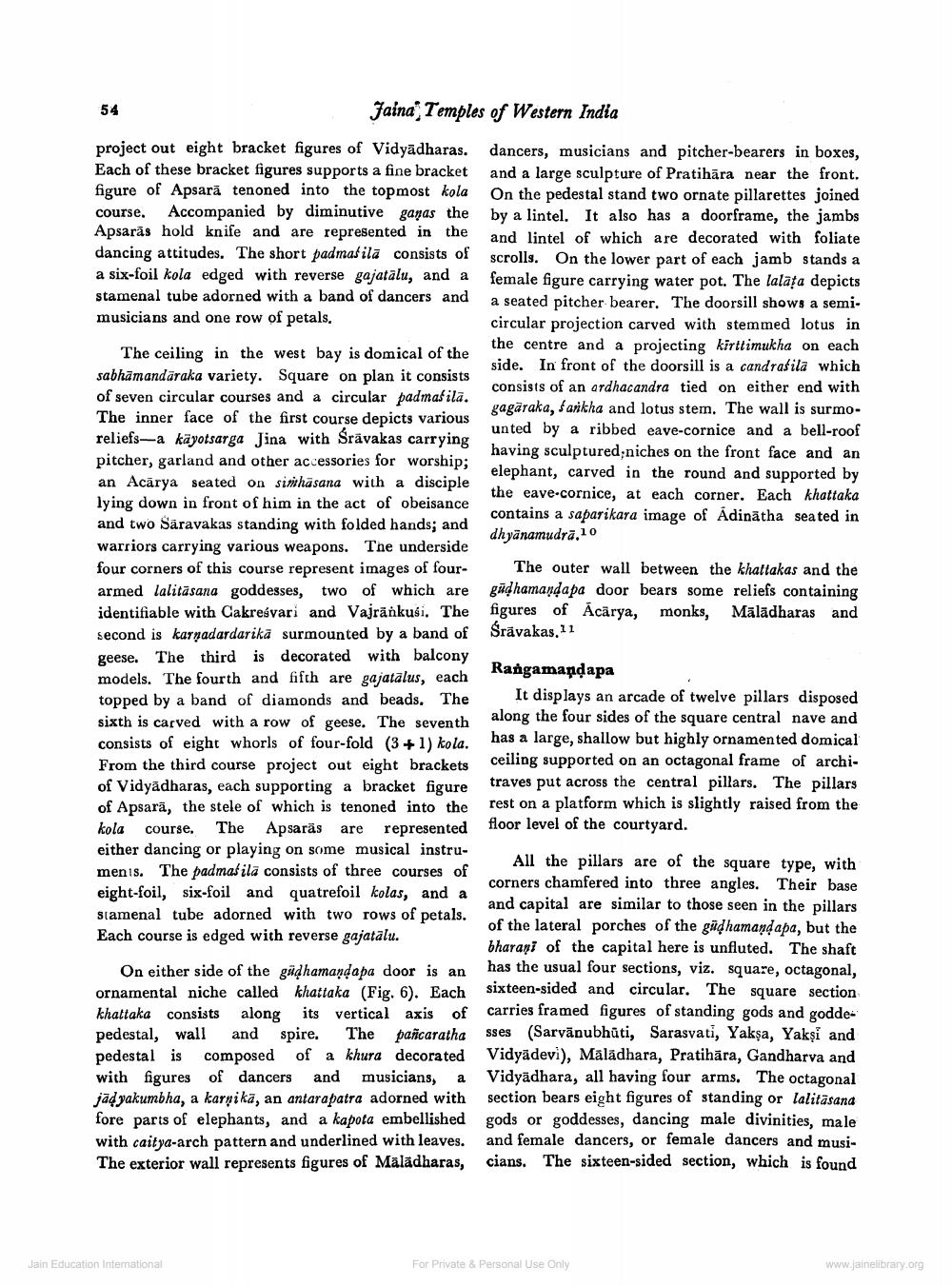________________
54
Faina Temples of Western India
project out eight bracket figures of Vidyadharas. Each of these bracket figures supports a fine bracket figure of Apsara tenoned into the topmost kola course. Accompanied by diminutive gamas the Apsaras hold knife and are represented in the dancing attitudes. The short padmašila consists of a six-foil kola edged with reverse gajatalu, and a stamenal tube adorned with a band of dancers and musicians and one row of petals.
dancers, musicians and pitcher-bearers in boxes, and a large sculpture of Pratihāra near the front. On the pedestal stand two ornate pillarettes joined by a lintel. It also has a doorframe, the jambs and lintel of which are decorated with foliate scrolls. On the lower part of each jamb stands a female figure carrying water pot. The lalața depicts a seated pitcher bearer. The doorsill shows a semicircular projection carved with stemmed lotus in the centre and a projecting kirttimukha on each side. In front of the doorsill is a candrašila which consists of an ardhacandra tied on either end with gagāraka, Sarkha and lotus stem. The wall is surmounted by a ribbed eave-cornice and a bell-roof having sculptured niches on the front face and an elephant, carved in the round and supported by the eave-cornice, at each corner. Each khattaka contains a saparikara image of Adinātha seated in dhyānamudrā.10
The outer wall between the khattakas and the gūdhamandapa door bears some reliefs containing figures of Acārya, monks, Mālādharas and Srāvakas.21
The ceiling in the west bay is domical of the sabhāmandāraka variety. Square on plan it consists of seven circular courses and a circular padmašila. The inner face of the first course depicts various reliefs-a kayotsarga Jina with Srävakas carrying pitcher, garland and other accessories for worship; an Acārya seated on sinihasana with a disciple lying down in front of him in the act of obeisance and two Säravakas standing with folded hands; and warriors carrying various weapons. The underside four corners of this course represent images of four- armed lalitāsana goddesses, two of which are identifiable with Cakreśvari and Vajrānkusi. The second is karnadardarikā surmounted by a band of geese. The third is decorated with balcony models. The fourth and fifth are gajatalus, each topped by a band of diamonds and beads. The sixth is carved with a row of geese. The seventh consists of eight whorls of four-fold (3 + 1) kola. From the third course project out eight brackets of Vidyadharas, each supporting a bracket figure of Apsara, the stele of which is tenoned into the kola course. The Apsaräs are represented either dancing or playing on some musical instrumenis. The padmašila consists of three courses of eight-foil, six-foil and quatrefoil kolas, and a stamenal tube adorned with two rows of petals. Each course is edged with reverse gajatālu.
nangamangapa
It displays an arcade of twelve pillars disposed along the four sides of the square central nave and has a large, shallow but highly ornamented domical ceiling supported on an octagonal frame of architraves put across the central pillars. The pillars rest on a platform which is slightly raised from the floor level of the courtyard.
On either side of the güdhamandapa door is an ornamental niche called khattaka (Fig. 6). Each khattaka consists along its vertical axis of pedestal, wall and spire. The pañcaratha pedestal is composed of a khura decorated with figures of dancers and musicians, a jad yakumbha, a karnika, an antarapatra adorned with fore parts of elephants, and a kapota embellished with caitya-arch pattern and underlined with leaves. The exterior wall represents figures of Maladharas,
All the pillars are of the square type, with corners chamfered into three angles. Their base and capital are similar to those seen in the pillars of the lateral porches of the gadhamand apa, but the bharani of the capital here is unfluted. The shaft has the usual four sections, viz. square, octagonal, sixteen-sided and circular. The square section carries framed figures of standing gods and godde sses (Saryānubhūti, Sarasvati, Yakşa, Yakşi and Vidyādevi), Maladhara, Pratihāra, Gandharva and Vidyādhara, all having four arms. The octagonal section bears eight figures of standing or lalitāsana gods or goddesses, dancing male divinities, male and female dancers, or female dancers and musicians. The sixteen-sided section, which is found
Jain Education International
For Private & Personal use only
www.jainelibrary.org




